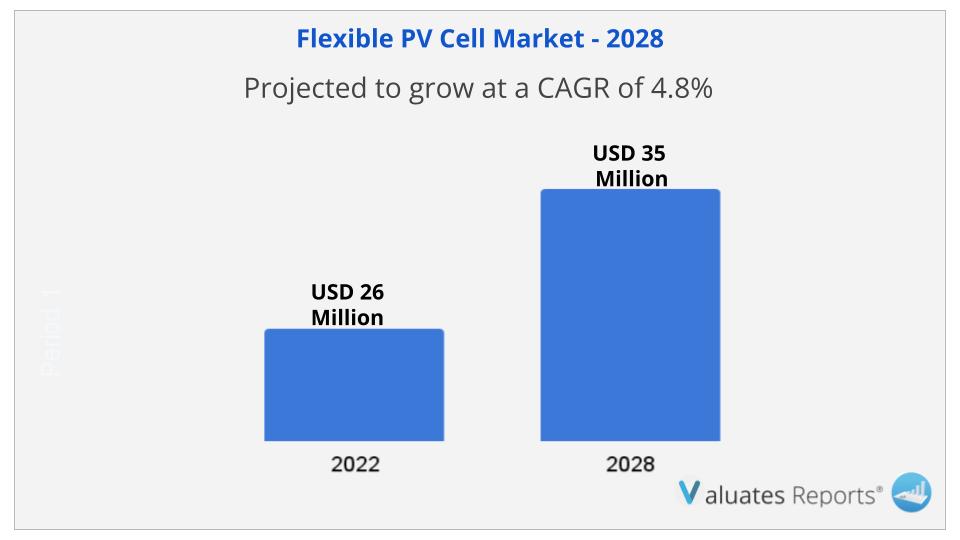
Considering the economic change due to COVID-19 and Russia-Ukraine War Influence, the global Flexible PV Cell market is projected to reach US$ 35 million by 2028 from an estimated US$ 26 million in 2022, at a CAGR of 4.8% during 2023 and 2028.

A flexible PV cell which is also known as thin film solar cell that is made by depositing very thin layers of photovoltaics material on any kind of substrate, such as, paper, tissue, plastic, glass or metal. It is one of the most revolutionary and epoch making technologies in the sector of solar energy.
The significance of the word “flexible” is that, these kind of solar cells are not like those traditional big, bulky solar panels which is very common nowadays, these are literally flexible, very thin, lightweight, have very little installation cost and can be installed anywhere without going much trouble.
Thickness of a typical cell varies from a few nanometers to few micrometers, whereas its’s predecessor crystalline-silicon solar cell (c-Si) has a wafer size up to 200 micrometers.
In this report, we define flexible PV cells as PV modues fabricated on flexible substrate materials (most commonly used substrates are polyimide, polyethylene terephthalate (PET), polyethylene naphthalate (PEN), and metal foils such as stainless steel (SS) and titanium (Ti)), including flexible a-Si thin film cells, flexible CIGS cells, flexible CdTe cells, OPV cells, flexible DSSC and flexible perovskite PV.
Silicon (Si) solar cells dominate the PV market (92%) followed by cadmium telluride (CdTe, 5%), copper indium gallium selenide (CuInGaSe2or CIGS, 2%) and amorphous silicon (a-Si:H, ~1%). Si wafer with thickness around 180 μm is the traditional materialbeing used for module manufacturing and it has attained significant level of maturity at the industrial level. Its production cost is amajor concern for energy applications. About 50% of the cost of Si solar cells production is due to Si substrate, and device processingand module processing accounts for 20% and 30% respectively.
An alternate to Si solar cells is the thin film solar cells fabricated on glass substrates. The main demerits of using glass substratesare fragile nature of modules, cost of glass wafer having thickness of 300–400 μm, and low specific power (kW/kg) etc. Specific poweris an important factor when solar cells are used in space applications. A high specific power exceeding 2 kW/kg can be achieved by flexible solar cells on polymer films which is useful for terrestrial as well as space applications. Production cost can be lowered byusing flexible substrates and roll-to-roll production (R2R) technique. Apart from light weight, flexibility and less cost of installation,flexible cell processing involves low thermal budget with low material consumption. Other than solar cell applications, smallerspecialized applications are beginning to become more viable independent markets, including applications for mobile power and building or product integration, which can benefit greatly from flexible thin film options. Flexible cells on buildings (known asbuilding integrated photovoltaics or BIPV) can minimize the cost of support, shipments etc., and installations can be handled easily. However, flexible solar cell technology is less mature when compared to the cells fabricated on rigid substrate counterpart.
Due to four main requirements - high efficiency, low-cost production, high throughput and high specific power, a major researchand development focus has been shifted towards flexible solar cells. It can offer a unique way to reach terawatt scale installation byusing high throughput R2R fabrication technique. Most commonly used substrates are polyimide, polyethylene terephthalate (PET), polyethylene naphthalate (PEN), and metal foils such as stainless steel (SS) and titanium (Ti).
The performance of flexible solar cells is comparable to rigid substrates. Flexible substrates are more advantageous than standardsoda-lime glass (SLG) substrates. As mentioned below, there are several merits of using flexible substrates:
Photovoltaic (PV) technologies are basically divided into two big categories: wafer-based PV (also called 1st generation PV) and thin-film cell PV. The emerging thin-film PVs are also called 3rd generation PVs, which refer to PVs using technologies that have the potential to overcome Shockley-Queisser limit or are based on novel semiconductors. The 3rd generation PVs include DSSC, organic photovoltaic (OPV), quantum dot (QD) PV and perovskite PV. The cell efficiencies of perovskite are approaching that of commercialized 2nd generation technologies such as CdTe and CIGS. Other emerging PV technologies are still struggling with lab cell efficiencies lower than 15%.
In the industry, Sun Harmonics shipments most in 2019 and recent years, while HyET Solar and PowerFilm, Inc. ranked 2 and 3. The top 3 Flexible PV Cell manufacturers accounted for around 62% revenue market share in 2019.
The manufacturer headquarters is mainly distributed in North America, Europe, China and Japan.
There are six types of Flexible PV Cell including Flexible CIGS Solar Cells, Flexible a-Si Solar Cells, Organic Solar Cells (OPV), Flexible CdTe Solar Cells, Flexible DSSC, Flexible Perovskite Solar Cells. In addition, the application consists of BIPV, Transportation & Mobility, Defense & Aerospace, Consumer & Portable Power. BIPV occupied nearly 51% of global flexible PV Cell sales market share in 2019.
This report aims to provide a comprehensive presentation of the global market for Flexible PV Cell, with both quantitative and qualitative analysis, to help readers develop business/growth strategies, assess the market competitive situation, analyse their position in the current marketplace, and make informed business decisions regarding Flexible PV Cell.
The Flexible PV Cell market size, estimations, and forecasts are provided in terms of sales volume (MW) and revenue ($ millions), considering 2021 as the base year, with history and forecast data for the period from 2017 to 2028. This report segments the global Flexible PV Cell market comprehensively. Regional market sizes, concerning products by types, by application, and by players, are also provided. The influence of COVID-19 and the Russia-Ukraine War were considered while estimating market sizes.
For a more in-depth understanding of the market, the report provides profiles of the competitive landscape, key competitors, and their respective market ranks. The report also discusses technological trends and new product developments.
The report will help the Flexible PV Cell manufacturers, new entrants, and industry chain related companies in this market with information on the revenues, sales volume, and average price for the overall market and the sub-segments across the different segments, by company, product type, application, and regions.
In this section, the readers will gain an understanding of the key players competing. This report has studied the key growth strategies, such as innovative trends and developments, intensification of product portfolio, mergers and acquisitions, collaborations, new product innovation, and geographical expansion, undertaken by these participants to maintain their presence. Apart from business strategies, the study includes current developments and key financials. The readers will also get access to the data related to global revenue, price, and sales by manufacturers for the period 2017-2022. This all-inclusive report will certainly serve the clients to stay updated and make effective decisions in their businesses. Some of the prominent players reviewed in the research report include:
Global markets are presented by Flexible PV Cell type, along with growth forecasts through 2028. Estimates on sales and revenue are based on the price in the supply chain at which the Flexible PV Cell are procured by the manufacturers.
This report has studied every segment and provided the market size using historical data. They have also talked about the growth opportunities that the segment may pose in the future. This study bestows sales and revenue data by type, and during the historical period (2017-2022) and forecast period (2023-2028).
This report has provided the market size (sales and revenue data) by application, during the historical period (2017-2022) and forecast period (2023-2028).
This report also outlines the market trends of each segment and consumer behaviors impacting the Flexible PV Cell market and what implications these may have on the industry's future. This report can help to understand the relevant market and consumer trends that are driving the Flexible PV Cell market.
This section of the report provides key insights regarding various regions and the key players operating in each region. Economic, social, environmental, technological, and political factors have been taken into consideration while assessing the growth of the particular region/country. The readers will also get their hands on the revenue and sales data of each region and country for the period 2017-2028.
The market has been segmented into various major geographies, including North America, Europe, Asia-Pacific, South America, Middle East & Africa. Detailed analysis of major countries such as the USA, Germany, the U.K., Italy, France, China, Japan, South Korea, Southeast Asia, and India will be covered within the regional segment. For market estimates, data are going to be provided for 2021 because of the base year, with estimates for 2022 and forecast revenue for 2028.
|
Report Metric |
Details |
|
Base Year: |
2021 |
|
Market Size in 2022: |
USD 26 million |
|
Forecast Period: |
2022 to 2028 |
|
Forecast Period 2023 to 2028 CAGR: |
4.8% |
|
2028 Value Projection: |
USD 26 million |
|
No. of Pages: |
101 |
|
Tables & Figures |
146 |
|
Segments covered: |
Type, Application, Region |
Ans. The forecast period in the Flexible PV Cell Market report is from 2022 to 2028.
Ans. The Chapter-wise Flexible PV Cell market report can be obtained on from the Valuates Reports website. Also, 24*7 chat support and direct call services are provided to procure the chapter-wise report.
Ans. CIGS,a-Si, OPV, Others are the segments by type in Flexible PV Cell Market.
Ans. Flexible PV Cell market is projected to reach US$ 35 million by 2028 from an estimated US$ 26 million in 2022, at a CAGR of 4.8% during 2023 and 2028.
Key Drivers & Barriers
Reasons to Buy This Report
$5900
$8850
$11800
HAVE A QUERY?
OUR CUSTOMER

Add to Cart
Add to Cart
Add to Cart
Add to Cart